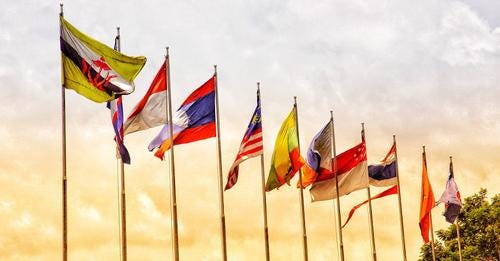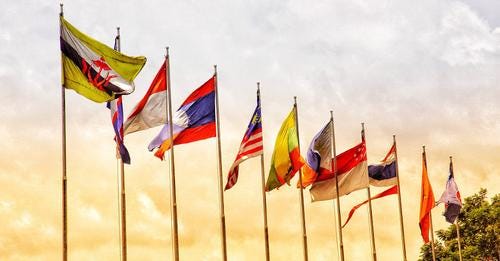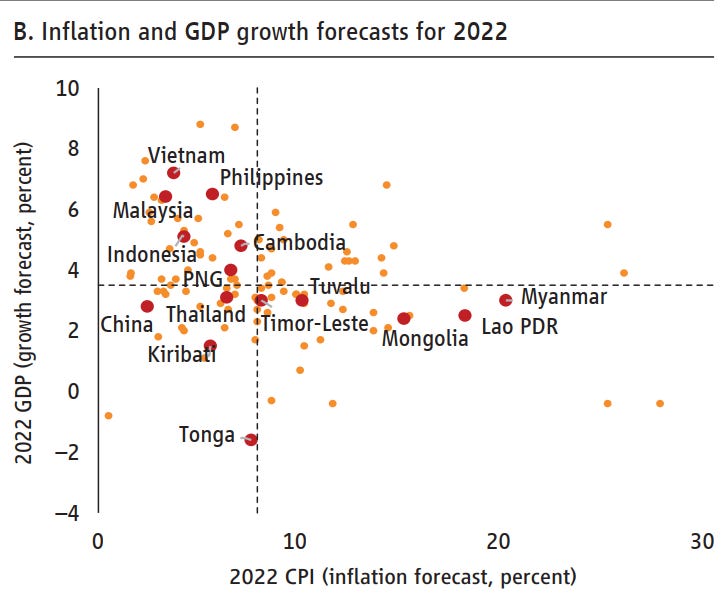The Great ASEAN Economic Rebound
Demand is growing again, making the region look like there was never any pandemic
While many parts of the world are faltering on the edge of recession, The ASEAN region in the first half of 2022 has been on an economic rebound. This shows that economies can be very robust in recovery after a calamity. Demand and investment are on the rise again, making the region look like there was never any pandemic.
GDP in Vietnam, the Philippines, and Malaysia are forecast by the World Bank to grow in excess of 6 percent, while Indonesia and Cambodia’s growth are expected around 5 percent. Singapore, Thailand, Lao PDR, and Myanmar are all expected to grow around the 3 percent mark.
Source: World Bank
Most of this grow has been underwritten by the strong growth of exports, a resurgence of local demand, and investment. There is massive urban development occurring across the region, with tourism very quickly rebounding after travel restrictions have been lifted. The streets are now vibrant with crowded markets and restaurants due to a new consumer confidence.
This is in great contrast to the rest of the world. China appears to still be conducting a zero Covid policy resulting in lockdowns, which is stifling economic growth. The US economy is slowing down due to rising fuel costs, while Europe is facing energy shortages.
However, this is not stopping massive Chinese investment into the region. The changes in Hong Kong have advantaged Singapore, where much of the Hong Kong financial industry is relocating to Singapore. Local companies within the region are also beginning to benefit from stage two of the Belt and Road Initiative (BRI), where government owned or controlled trading companies are buying up resources and commodities in the region for export back to China.
However, some of the ASEAN countries are facing a number of potential problems. Although exports have been rapidly growing in Indonesia, Malaysia, and Vietnam, the international economic slowdown could dampen demand later in the year, and into 2023. To some degree this could be balanced by a massive rise in international tourism, but this will distort any semblances of balanced growth.
Weakening currencies, increasing public and private debt, rising energy costs, and a massive expansion of the money supply over the last two years has fuelled a bout of inflation. This is particularly the case in Indonesia, the Philippines, Cambodia, Thailand, the Lao PDR, and Myanmar.
The major concern over inflation, is not the inflation itself, by the response of central banks in raising interest rates, which could dampen domestic demand and investment.
Most economic analysts still believe ASEAN will remain relatively buoyant over the next year. There are some concerns in Singapore that the property bubble could burst. However, the IMF has raised Malaysia’s GDP growth expectation to 5.4% this year, although forecasting a dip to 4.4% in 2023. This is down from an earlier 4.7% estimate.
ASEAN’s economic resurgence has created some chronic labour shortages in Singapore, Malaysia, and even Thailand. This could hamper potential construction and manufacturing growth, if these issues are not resolved.
ASEAN governments must address the growing increase in wealth inequality that was exasperated during the pandemic. Large portions of ASEAN populations have experienced losses in their relative income levels as inflation dips into spending power of disposable incomes. Large numbers of families in the lower to middle income levels, are finding it difficult to cope with the rising cost of living. Purchasing power will continue to erode over the next 12 months. Relative poverty levels would be expected to increase accordingly.
The major economic shift within ASEAN is the growing level of intra-ASEAN trade and investment. This is where the ASEAN grouping may be partly protected from any world economic downturn.
ASEAN brands and franchises are becoming very prominent in the region today, showing growing intra-ASEAN trade and investment.
As commodities like rubber and palm oil prices have been lacklustre, exports of manufactured products have partly offset this. Manufacturing has been attracted to the region due to the relatively low-cost regimes across the region. ASEAN governments have not been as concerned about renewable energies and environmental issues, as their western counterparts.
In the short-term ASEAN has a buffer against any upcoming international recession. However, it’s not known how deep and long any potential recession will be. What happens in China will be crucial for ASEAN.
However, there is some pessimism about domestic demand in 2023. These perceptions are driven more by the uncertainty of the international situation, speculation over interest rates, and news of an international recession. The situation in China also appears uncertain as capital flight from China has increased since the Communist Party’s 20th Congress, where Xi Jinping, was elected for a third term as president. China is now the largest trading partner of most ASEAN nations, and a major source of foreign investment. However, some capital flight will find its way into ASEAN economies, where for example, the Cambodian economy feeds off illicit Chinese money.
The challenges ahead for ASEAN will be keeping debt and inflation in control, dealing with lower export and foreign investment growth, dealing with eroding currency exchange rate rates, and another bout of foreign currency speculation, if the world goes into a deep recession.
Meanwhile, the urban landscapes across the region show heavy investment in construction. The key will be that this is not speculative and based on rising demand. Otherwise, the bubble could burst on this post-Covid rebound.
Originally published in Eurasia Review 3rd November 2022
Subscribe Below:






Haha foolish article with poor insight. Watching global bond market crashing and you're telling me asea is fine. Haha good joke.